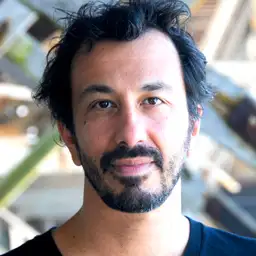
Blaine is a category pioneer, an idea-stage investor and advisor, an artist, and an inventor. He has nearly 30 years of experience launching and commercializing innovations in the technology, media, and gaming industries.
Key Takeaways
(03:04-11:51) Film, TV and the game world
(11:51-22:55) Solving the problem you're setting out to solve
(22:55-29:12) Maximizers and satisfiers
(29:12-43:00) The Power of Concise Communication
📱 Apple Podcasts | 🎧 Spotify | 🔗 iHeart
Creative Innovation & Strategic Investment
Blaine Graboyes is a highly accomplished artist, inventor, and founder with a diverse background spanning film, television, video games, and the casino gambling industry. He co-founded the first DVD production company in New York and subsequently produced video games across all major platforms, including pioneering set-top box gaming. His entrepreneurial spirit led him to the E-sports sector and the invention of the first video game gambling machines, which he also brought online.
Currently residing in Europe, Blaine is actively involved as an investor and advisor, focusing on early-stage "idea stage" companies. Leveraging his extensive experience and creative insights, he provides impactful guidance to help these ventures succeed. His unique career trajectory demonstrates a consistent drive to innovate and contribute to various dynamic industries.
1. Film, TV and the game world
Drawing upon extensive experience as a producer in film, TV (Producers Guild of America member and former co-chair), and video games, Blaine brings a unique perspective to early-stage investing. He equates producing a show with building a startup, emphasizing the transferable skills in creating an entity, business planning, team recruitment, funding, strategy, execution, and marketing. Blaine advises startups on the crucial distinction between the binary outcomes of venture capital (exit or bankruptcy) versus the potentially varied successes in creative productions.
A key insight Blaine offers is the paramount importance of storytelling for early-stage companies, as it forms the foundation before a tangible product, market, or revenue exists. He also highlights the shared emotional experience between completing a creative project and closing a fundraising round, noting a potential sense of deflation after intense periods of focused effort. Blaine's background provides a valuable lens for understanding team dynamics, consumer engagement, and the narrative construction essential for entrepreneurial success.
The other thing that comes to mind about the crossover between film, TV, games, and startups is storytelling. For early-stage companies, it's all about the story because that's all you have. There isn't a product, market, or revenue. It's the idea, how you'll execute it, and what it will become that matters. — Blaine Graboyers
2. Solving the problem you're setting out to solve
Blaine emphasizes that while raising capital is a common approach for early-stage companies, it's not always the optimal or necessary solution. He highlights alternative paths such as debt financing, equity through revenue generation, operational efficiency, and strategic partnerships. Drawing from his experience, Blaine underscores the importance of focusing on the core problem a startup aims to solve and the long-term commitment required.
Illustrating a "less is more" approach, Blaine shares his recent venture into a coffee company with a mission to return 50% of retail profits to Ugandan farmers. This initiative aims to disrupt the traditional wholesale model by creating a supply chain where benefits are shared. He further exemplifies this philosophy in their website design, which distills nearly 70 years of history into a few impactful photos and concise paragraphs to create a repeatable story. Blaine advocates for simplicity, quality over quantity, smaller focused teams, and pursuing one exceptional endeavor rather than many modest ones, aligning with the principle that "perfection is not when you can't add anything, but when you can't take anything away." He also cautions against building unnecessary product features, as they represent the most significant waste of resources for startups.
The point is you need to tell a story that people can easily repeat. I think the few-as-best approach applies to almost everything. I basically wear the same thing every day. I'm very simple in my personal life and habits. I'd rather have something high quality or nothing. I'd rather work with a small team than a big team. I'd rather do one thing that's amazing than 10 things that are modest. And I think that's a way that people can really approach startups, it’s a bit subjective, but people can actually apply it in their business and personal lives. — Blaine Graboyers
3. Maximizers and satisfiers
While unfamiliar with the terms "maximizer" and "satisfier," Blaine describes his decision-making process as a blend of intuition and rapid analysis. He emphasizes that while the exact mechanisms of human decision-making remain unclear from a scientific perspective, he finds that following intuition to generate an initial idea must be quickly followed by analysis, not as a prolonged pursuit of perfection, but as a means to quickly assess viability, such as through basic financial modeling like revenue projections.
Blaine believes this iterative cycle of idea generation followed by swift analysis is crucial for startups and CEOs. The ability to both envision creatively and analyze pragmatically allows for course correction and refinement of ideas. He highlights that committing to any endeavor, whether business-related or personal, holds the potential to evolve beyond initial expectations.
4. The Power of Concise Communication
Blaine notes a significant improvement in the quality of storytelling across businesses, particularly in tech startups, facilitated by the abundance of available platforms and tools. He emphasizes the critical importance of a concise and compelling pitch deck (5-10 slides) as the primary communication asset for an early-stage company. This deck should convey the business essence within five minutes, utilizing visuals to enhance understanding and engagement, whether for fundraising, securing loans, or simply explaining the venture. A well-crafted, easily shareable PDF provides a positive initial experience and ensures the core message is effectively delivered.
Drawing a parallel to the "Crit" process in art school, where immediate feedback is central, Blaine stresses the importance of a tight feedback loop in business. However, he cautions that feedback is only valuable if the underlying reasons are truly understood. He shifts the focus from the problem statement in a pitch deck to the reasons and causes behind the problem. According to Blaine, a successful solution directly addresses these root causes, ensuring that the product or service effectively meets a fundamental need. He illustrates this with the example of a client seeking confidence in presentations, suggesting that the root cause is the need for reassurance rather than simply wanting a visually appealing presentation.
In five minutes or less, I have to get it all and have to be like 90% correct in my understanding and interpretation of it. Whether that means photos, icons, or graphics, the content is the content. Being able to package it in a way that is engaging, fun, and easy to download. I think the single most important asset of a business is its pitch stack of 5 to 10 slides. When pitching, whether you're fundraising, telling the story to a bank to get a loan, or your parents so they can be proud of you, you've got to be able to send someone a PDF that they can open immediately. — Blaine Graboyers
Other Episodes

Godard Abel | CEO of G2
S 01 | Ep 6 Where You Go for Software: Reach Your Peak

Dean Stocker | CEO of Alteryx
S 01 | Ep 8 Turning Your Customers Into Your Biggest Champions

Peter Fader | Co-Founder of Theta CLV
S 01 | Ep 10 Turning Your Marketing Into Dollars